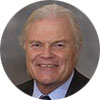Download PDF

By William L. Rich III, MD, FACS, 2016 Academy President
Back in the late 1970s, when I was taking my oral boards, I ran into the Academy’s then EVP, Bruce Spivey, MD, and asked about his concerns with the National Health Planning Act. His response: “What in the world are you talking about? Send me a letter next week!”
That exchange altered the trajectory of my professional life, leading to more than 30 years of service to the profession. I mention this as a quintessential example of the Academy’s culture. Unlike many other medical associations, the Academy has always looked beyond the ladder of seniority and reached out to younger ophthalmologists for committee and leadership positions. And we will continue to do so. Our young ophthalmologists are whip smart and have much to offer. They give me hope for the future.
Ophthalmology also has a long-standing culture of commitment to clinical and scientific excellence, as evidenced by the rich tapestry of accomplishments we often take for granted. For instance, the first true randomized clinical trial was conducted in 1950 by Arnall Patz, MD, and Leroy Hoeck, MD, on the link between oxygen levels and blindness in premature infants. In another great advance in public health, Alfred Sommer, MD, investigated the association of low levels of vitamin A with infant mortality and blindness. And Matthew Davis, MD, a camera buff, designed the DRS (Diabetic Retinopathy Study) and ETDRS, which set standards for fundus photography. More recently, the CATT trial is a model for modern comparative effectiveness research.
When you look at this extraordinary history, you realize what giants we’ve had—and continue to have—in our profession. They’ve had a profound impact not only on ophthalmology but also on all of medicine. And the strength of their intellectual vigor, their sense of service, and their dedication to expanding knowledge continue to permeate our profession.
On a sobering note, there’s no question that the next 4 to 6 years will be a challenging time—perhaps the most tumultuous of the last 50 years—in American medicine. The current health policy agenda calls for eliminating fee for service. The argument is that health care can be delivered more efficiently and with better outcomes if physicians are employed in integrated systems organized around the hospital. We have never before faced an agenda that is so disconnected from economic and clinical reality. It is terrifying that 16% of the GDP—that is, health care expenditures—is being redirected toward something that is unsupported by the evidence.
External threats such as this can’t be ignored; they have to be addressed. But I am an optimist; I believe that such challenges can be overcome if you understand the environment and deliberately chart a path forward. We have the culture and the infrastructure to deal with this latest challenge. We’ve always done the right thing and kept the big picture—patient care—in focus. In this instance, the policy of rewarding outcomes was anticipated by the Academy, which launched the IRIS Registry. I believe that if we stay the course and remain focused on patient care, we will continue to prosper.
I also encourage my colleagues to not be disconcerted or thrown off balance by the intrusion of information technology (IT) into the practice of medicine. Ironically, I’m a bit of a troglodyte when it comes to technology: I don’t wear a watch, and I can’t make an iPhone work. But I believe that health IT can dramatically shorten the timeline for the dissemination of important clinical knowledge, thus leading to better outcomes. The IRIS Registry can help compress this time frame by taking new evidence from the literature, forming measures to enable us to see how we’re doing, and quantitatively measuring our improved outcomes—and it can do so seamlessly, immediately, and even longitudinally.
As ophthalmologists, we can be proud of our history and our mission. We have a strong advocacy effort here in Washington, and that—plus our continued emphasis on quality, excellence, innovation, and education—means that the Academy is well positioned to protect the profession and our patients.